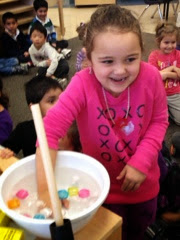Readers use their SCHEMA to understand Fiction and
Non-Fiction.
Schema is all of the information in our brains.
Schema can change and get bigger, and we can fix our schema as we learn new information.
We are learning to ask ourselves these questions
when reading:
1. What do I already know about __________ ?
2. What am I learning about __________ that is new?
3. How does what I am learning change my ideas about _________?
4. Does it remind me of another book I have read?
5. Does it remind me of something that happened to me?
We created a list of facts about penguins to help us use our SCHEMA when reading independently or with a partner
"Penguins Can't Fly: Two Friends Become TRUE Friends!" by Richard Byrne tells the story of two baby birds who become friends: Gregory the gull and Hudson the penguin. As they grow, they do everything together--until the time comes for Gregory to fly. Hudson tries to fly along with his gull friend, only to find out that penguins can't fly. No matter how hard he tries, he simply cannot fly and the other gulls make fun of him. Later, when the gulls go diving for fish, Hudson discovers that his friend, Gregory is missing. That's when Gregory and the other gulls discover something special that only a penguin can do. He is able to dive deep beneath the ocean's surface, free Hudson from a fisherman's net, and bring him back to shore. On this important day, the other gulls learn what a true friend Hudson really is.
This is our "Making Connections" bulletin board. Our students enjoy listening to different read-alouds during our literacy circle. For this activity we listened to "Penguins Can't Fly." After the read-aloud, students put on their "Thinking Caps" and thought about what the story reminded them of and practised making text-self connections. One student wrote, "It reminds me of when my brother told me that I could not learn a new soccer skills. I felt sad." Another student said, "It reminds me of when my brother says, 'You can't swim.' I feel sad."
Have you ever wondered how polar bears stay warm during the Winter months in Antarctica? Well, it's because they have a layer of fat under their skin. For this experiment, we placed our hands in cold water with ice cubes. We quickly took our hands out of the water because the water was too cold. During the final part of the experiment, one student put on a rubber glove that was covered in lard (fat). When she placed her hand in the cold, icy water she was able to keep it in longer because her glove was covered with a layer of lard (fat), which kept her hand warm.
Dramatic play at the sensory table. We are having fun working together to create an Arctic habitat with ice, polar bears and water.
Have you ever wondered why penguin feather don't stay wet after swimming in the ocean? Well, it's because their feathers are oily, which prevents their feathers from absorbing water. For this experiment, we placed water in the first tray, oil in the second tray, and a mixture of water in oil in the third tray. We then put food colouring in each tray and observed different changes that occurred. The water-filled tray absorbed the food colouring and the oil-filled tray did not absorb the food colouring. We learned that oil repels food colouring, much like how penguin feathers repel water and keep them dry.
Having fun walking with penguin eggs on our feet!!!
Are you as tall as an Emperor Penguin or a Macaroni Penguin?
We made penguin treats using frozen bananas, chocolate chips and Smarties. They were DELICIOUS!!!
























No comments:
Post a Comment